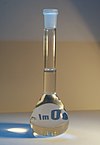 Global Information
Global InformationIsopropyl alcohol information
| |||

| |||
| Names | |||
|---|---|---|---|
| Preferred IUPAC name
Propan-2-ol[2] | |||
| Other names
2-Propanol
Isopropanol[1] Rubbing alcohol sec-Propyl alcohol 2-Hydroxypropane i-PrOH Dimethyl carbinol IPA | |||
| Identifiers | |||
CAS Number
|
| ||
3D model (JSmol)
|
| ||
Beilstein Reference
|
635639 | ||
| ChEBI |
| ||
| ChEMBL |
| ||
| ChemSpider |
| ||
| ECHA InfoCard | 100.000.601 | ||
Gmelin Reference
|
1464 | ||
| KEGG |
| ||
PubChem CID
|
| ||
| RTECS number |
| ||
| UNII |
| ||
| UN number | 1219 | ||
CompTox Dashboard (EPA)
|
| ||
InChI
| |||
SMILES
| |||
| Properties | |||
Chemical formula
|
C3H8O | ||
| Molar mass | 60.096 g/mol | ||
| Appearance | Colorless liquid | ||
| Odor | Pungent alcoholic odor | ||
| Density | 0.786 g/cm3 (20 °C) | ||
| Melting point | −89 °C (−128 °F; 184 K) | ||
| Boiling point | 82.6 °C (180.7 °F; 355.8 K) | ||
Solubility in water
|
Miscible with water | ||
| Solubility | Miscible with benzene, chloroform, ethanol, diethyl ether, glycerol; soluble in acetone | ||
| log P | −0.16[3] | ||
| Acidity (pKa) | 16.5[4] | ||
Magnetic susceptibility (χ)
|
−45.794·10−6 cm3/mol | ||
Refractive index (nD)
|
1.3776 | ||
| Viscosity | 2.86 cP at 15 °C 1.96 cP at 25 °C[5] 1.77 cP at 30 °C[5] | ||
Dipole moment
|
1.66 D (gas) | ||
| Pharmacology | |||
ATC code
|
D08AX05 (WHO) | ||
| Hazards | |||
| Occupational safety and health (OHS/OSH): | |||
Main hazards
|
Flammable, mildly toxic[6] | ||
| GHS labelling: | |||
Pictograms
|
 
| ||
Signal word
|
Danger | ||
Hazard statements
|
H225, H302, H319, H336 | ||
Precautionary statements
|
P210, P261, P305+P351+P338 | ||
| NFPA 704 (fire diamond) | 
1
3
0 | ||
| Flash point | Open cup: 11.7 °C (53.1 °F; 284.8 K) Closed cup: 13 °C (55 °F) | ||
Autoignition
temperature |
399 °C (750 °F; 672 K) | ||
| Explosive limits | 2–12.7% | ||
Threshold limit value (TLV)
|
980 mg/m3 (TWA), 1225 mg/m3 (STEL) | ||
| Lethal dose or concentration (LD, LC): | |||
LD50 (median dose)
|
| ||
LC50 (median concentration)
|
| ||
LCLo (lowest published)
|
| ||
| NIOSH (US health exposure limits): | |||
PEL (Permissible)
|
TWA 400 ppm (980 mg/m3)[7] | ||
REL (Recommended)
|
TWA 400 ppm (980 mg/m3), ST 500 ppm (1225 mg/m3)[7] | ||
IDLH (Immediate danger)
|
2000 ppm[7] | ||
| Safety data sheet (SDS) | [1] | ||
| Related compounds | |||
Related alcohols
|
1-Propanol, ethanol, 2-butanol | ||
| Supplementary data page | |||
| Isopropyl alcohol (data page) | |||
Except where otherwise noted, data are given for materials in their standard state (at 25 °C [77 °F], 100 kPa).
Infobox references
| |||
Isopropyl alcohol (IUPAC name propan-2-ol and also called isopropanol or 2-propanol) is a colorless, flammable organic compound with a pungent alcoholic odor.[9]
Isopropyl alcohol, an organic polar molecule, is miscible in water, ethanol, and chloroform, demonstrating its ability to dissolve a wide range of substances including ethyl cellulose, polyvinyl butyral, oils, alkaloids, and natural resins. Notably, it is not miscible with salt solutions and can be separated by adding sodium chloride in a process known as salting out. It forms an azeotrope with water, resulting in a boiling point of 80.37 °C and is characterized by its slightly bitter taste. Isopropyl alcohol becomes viscous at lower temperatures, freezing at −89.5 °C, and has significant ultraviolet-visible absorbance at 205 nm. Chemically, it can be oxidized to acetone or undergo various reactions to form compounds like isopropoxides or aluminium isopropoxide. As an isopropyl group linked to a hydroxyl group (chemical formula (CH3)2CHOH) it is the simplest example of a secondary alcohol, where the alcohol carbon atom is attached to two other carbon atoms. It is a structural isomer of propan-1-ol and ethyl methyl ether. They all have the formula C3H8O.
It was first synthesized in 1853 by Alexander William Williamson and later produced for cordite preparation. It is produced through hydration of propene or hydrogenation of acetone, with modern processes achieving anhydrous alcohol through azeotropic distillation. Beyond its production, isopropyl alcohol serves in medical settings as a rubbing alcohol and hand sanitizer, and in industrial and household applications as a solvent. It is a common ingredient in products such as antiseptics, disinfectants and detergents. More than a million tonnes are produced worldwide annually. Despite its utility, isopropyl alcohol poses safety risks due to its flammability and potential for peroxide formation. Its ingestion or absorption leads to toxic effects including central nervous system depression and coma, primarily treated through supportive measures.
- ^ "Alcohols Rule C-201.1". Nomenclature of Organic Chemistry (The IUPAC 'Blue Book'), Sections A, B, C, D, E, F, and H. Oxford: Pergamon Press. 1979.
Designations such as isopropanol, sec-butanol, and tert-butanol are incorrect because there are no hydrocarbons isopropane, sec-butane, and tert-butane to which the suffix "-ol" can be added; such names should be abandoned. Isopropyl alcohol, sec-butyl alcohol, and tert-butyl alcohol are, however, permissible (see Rule C-201.3) because the radicals isopropyl, sec-butyl, and tert-butyl do exist.
- ^ Favre, Henri A.; Powell, Warren H. (2014). Nomenclature of Organic Chemistry : IUPAC Recommendations and Preferred Names 2013 (Blue Book). Cambridge: The Royal Society of Chemistry. p. 631. doi:10.1039/9781849733069. ISBN 978-0-85404-182-4.
- ^ "Isopropanol_msds". chemsrc.com. Archived from the original on 10 March 2020. Retrieved 4 May 2018.
- ^ Reeve, W.; Erikson, C. M.; Aluotto, P. F. (1979). "A new method for the determination of the relative acidities of alcohols in alcoholic solutions. The nucleophilicities and competitive reactivities of alkoxides and phenoxides". Can. J. Chem. 57 (20): 2747–2754. doi:10.1139/v79-444.
- ^ a b Yaws, C.L. (1999). Chemical Properties Handbook. McGraw-Hill. ISBN 978-0-07-073401-2.
- ^ Isopropyl alcohol toxicity
- ^ a b c NIOSH Pocket Guide to Chemical Hazards. "#0359". National Institute for Occupational Safety and Health (NIOSH).
- ^ a b c d "Isopropyl alcohol". Immediately Dangerous to Life or Health Concentrations (IDLH). National Institute for Occupational Safety and Health (NIOSH).
- ^ "Isopropanol". PubChem. Archived from the original on 12 February 2019. Retrieved 10 February 2019.

